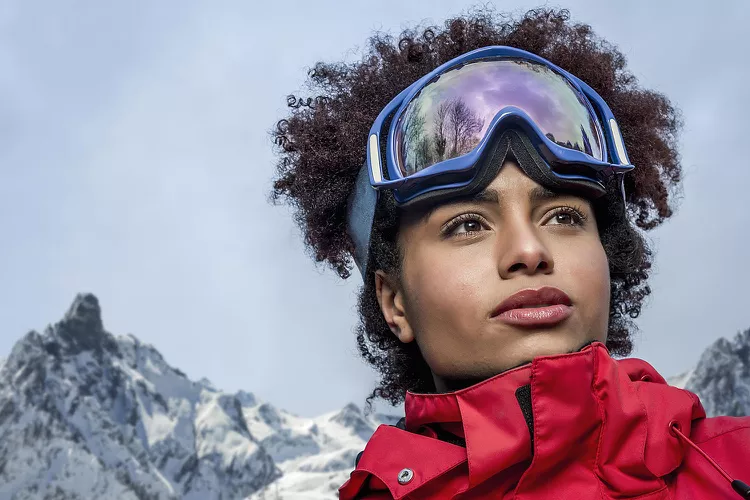Summary
- Clear Ski Goggle Lenses
- Pink Ski Goggle Lenses / Rose Ski Goggle Lenses
- Yellow Ski Goggle Lenses
- Amber Ski Goggle Lenses / Orange Ski Goggle Lenses
- Black Ski Goggle Lenses
- Brown Ski Goggle Lenses / Bronze Ski Goggle Lenses
- Red Ski Goggle Lenses
- Green Ski Goggle Lenses
- Blue Ski Goggle Lenses
- Violet Ski Goggle Lenses
- Photochromic Ski Goggle Lenses
Of all your skiing accessories, goggles are one of the most important, significantly impacting your visibility on the slopes. Ski goggle lenses are available in a variety of colors, including blue, green, pink, yellow, gold, black, and even metallic silver.
While certain ski goggle lenses excel in flat light, others shine on bright “blue bird” days (cloud-free/blue sky). If you need guidance on which to choose, this guide elaborates on ski goggle lens colors, detailing which types to buy for both low light and sunny conditions.
Clear Ski Goggle Lenses

Clear ski goggles are best for conditions with extremely low light and are essential for night skiing. Although these lenses do not alter color tones or depth perception, they protect your eyes from harsh elements. Additionally, clear ski goggles with UV protection remain crucial for safeguarding against UV radiation even on low-light days.
Pink Ski Goggle Lenses / Rose Ski Goggle Lenses

Pink ski goggle lenses are perfect for low-to-mid light conditions. They are suitable for partly cloudy or overcast days with reduced light and are good choices for skiing at dusk or dawn. However, avoid using pink lenses during sunny days as they may not filter bright light effectively.
Yellow Ski Goggle Lenses

Yellow or gold ski goggle lenses work exceptionally well in flat light, helping enhance details for navigating moguls and avoiding rough spots. Their tint sharpens vision on snowy days, filtering out the snow’s brightness. Because they effectively filter blue light, these lenses can also be suitable for sunny conditions, making them an excellent all-around choice.
Amber Ski Goggle Lenses / Orange Ski Goggle Lenses

Amber ski goggle lenses are suitable for overcast weather, but they also perform well on partly cloudy or sunny days. They enhance visibility by making moguls more distinguishable and aid effectiveness in foggy conditions. For especially foggy or overcast weather, a “copper”-colored lens may be beneficial.
Black Ski Goggle Lenses

For exceptionally bright blue bird days, consider wearing black or dark grey ski goggle lenses. These lenses do not change the perceived color tint and effectively block a significant amount of ultraviolet light. The addition of a “black iridium” mirrored finish further reflects sunlight, providing enhanced protection. However, it’s advisable to avoid black lenses during night skiing or in flat light conditions.
Brown Ski Goggle Lenses / Bronze Ski Goggle Lenses

For sunny days, brown or bronze ski goggle lenses are recommended as they enhance contrast and depth perception, making them ideal for bright conditions. Many brown lenses are polarized, further reducing glare caused by sunlight reflecting off the snow. Consequently, avoid these lenses during overcast conditions.
Red Ski Goggle Lenses

Red lens tints are optimal for medium to bright light conditions. Often referred to as “vermillion,” these lenses improve color definition and perception. They can also be combined with other lens colors to enhance versatility and darken the lens overall.
Green Ski Goggle Lenses

Green ski goggle lenses enhance contrast and improve depth perception while reducing eye fatigue on sunny days. They also boost visual definition in lower light conditions. Ideal for partly cloudy skiing, green lenses filter glare effectively and can adapt to brighter environments.
Blue Ski Goggle Lenses

Blue lenses can be utilized in low light conditions but mirrored blue ski goggle lenses work well in brighter light too. They reduce glare efficiently, especially when combined with a bronze or copper base tint. Depending on the lighting, a blue lens can be paired with various tints for optimal performance.
Violet Ski Goggle Lenses

Violet ski goggle lenses enhance color contrast, particularly with greens and blues, while maintaining natural color perception. They improve detail, making it easier to navigate bumps and identify icy patches, making them best for low-to-moderate light conditions.
Photochromic Ski Goggle Lenses

Photochromic ski goggles adjust to lighting conditions, darkening in bright light while remaining clear in flat light. This seamless transition optimizes visual accuracy across all conditions, offering great versatility for skiers.





